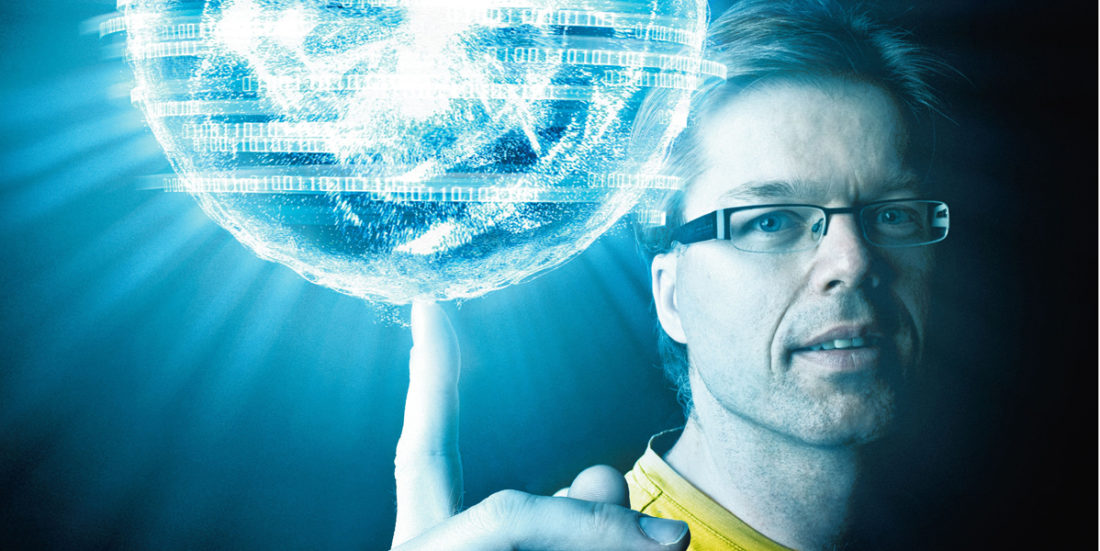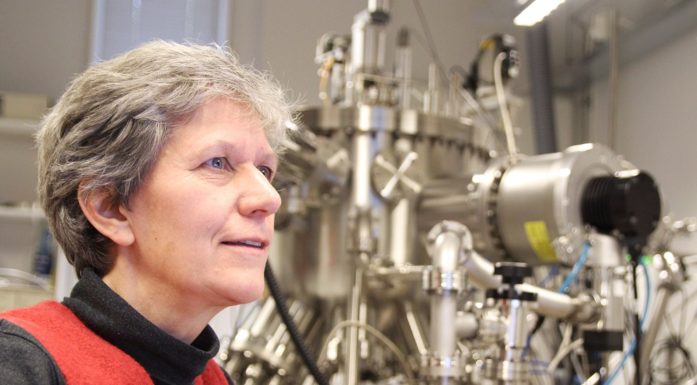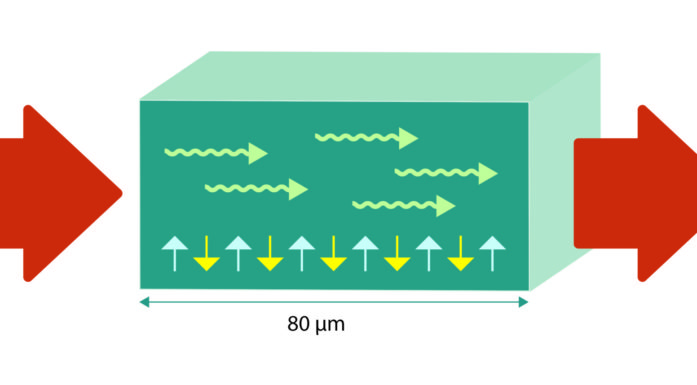A spin on the future
The science of spintronics, where the spin of an electron is used to create new technologies, may hold the key to making ever faster and lighter consumer products.
When NTNU Professor Arne Brataas purchased his first computer as a teenager in 1982, it was both a personal scientific benchmark and a coming-of-age experience. The machine was a Sinclair ZX Spectrum, with a 48 kb RAM, an external cassette player as a storage medium, and a speed of 4 MHz. The ZX Spectrum name, as Brataas wryly notes 27 years later, was meant to suggest its lightning fast speed, like a turbocharged rally car.
It might be a bit of an understatement to say that both Brataas and the computer world have grown and changed. Brataas went on to do his PhD at NTNU in condensed matter physics, with postdoctoral positions at TU Delft and Harvard. And today’s home computers are more than 1000 times faster than Brataas’s rally car Sinclair ZX, with 10,000 times more memory. Think of it this way: in 1979, just before Brataas bought his machine, the cutting-edge Motorola 68000 microprocessor had 68 thousand transistors on it. In 2009, Intel’s Core i7 microprocessor chip was crammed with 731 million transistors.
Now, researchers like Brataas are working to expand the limits of how much information can be packed onto a computer chip. But the computer chips of tomorrow they envision won’t necessarily be made of silicon – they could be based on other materials such as carbon. And if scientists like Brataas have anything to say about it, this new variety of chip won’t use the charge of an electron to carry the endless binary code of 0s and 1s that is at the foundation of all computing. Instead, they’ll take advantage of a wholly different feature of an electron – its spin.
Moore’s Law and MP3 players
It’s impossible to talk about computer processing power without at least a nod to Gordon Moore, the cofounder of Intel, who predicted in 1975 that the number of transistors on a computer chip would double every two years. The power of exponential growth is what transformed the 68 thousand transistors on the Motorola chip into the Intel i7’s 731 million transistors.
But the computing world is fast approaching the limits of what can be done to jam ever more transistors onto a chip. Current computer chips have silicon transistors with lines that are less than 100 nanometres thick – or roughly 1000 times smaller than the diameter of a human hair. And as transistors shrink in size, the sheer number of transistors crammed onto a chip generate an enormous amount of heat. Heat, in fact, is what limits the speed of the modern day PC. Speeds of 5 gigahertz using current technologies would result in chips hot enough to melt the silicon that they’re based on.

Arne Brataas, a professor of physics at NTNU, doesn’t need a laboratory to do his groundbreaking research. Instead, he has a blue couch. Photo: Geir Mogen
Not just a quirky feature
Enter spin. Although it was first described in an equation in 1928, spin was mostly thought to be merely a quirky feature of electrons in electronic devices until 1988, when the Frenchman Albert Fert and the German Peter Grünbergboth discovered GMR (giant magnetoresistance). Essentially, an electron’s spin also generates a small magnetic field. When a metal is magnetic, all the electron spins are oriented in the same direction (which is why they are magnetic), whereas with non-magnetic materials, the electron spins are randomly oriented, so that the magnetic charges cancel each other out.
In GMR, layers of ferromagnetic metals just a few atoms thick interspaced with a non-magnetic metal allow very weak magnetic changes to make major differences in electrical resistance. GMR read heads can thus detect these weak magnetic changes. That allows magnetic data to be stored more tightly on GMR hard drives than in other hard drives. Nearly all hard drives made since 1997 have relied on some version of this technology.
But the most dramatic evidence of how GMR has changed the world of electronics is probably in your pocket or purse: MP3 players and iPods exploit GMR to shrink the size of the hard drive, reduce power consumption and increase speed. That’s why it’s possible to carry around a 2GB MP3 player in your hand.
GMR is the first commercial example of how spin can make for dramatic technological change, but it is far from the last. Physicists envision a fleet of new devices, from new kinds of computer memory to new kinds of microprocessors that rely on spin – which, because they are based on magnetism, can be highly efficient and much smaller than conventional devices. But making them will require a deep understanding of electron spin and how it behaves in different materials and in different situations. That’s where Brataas and his team come in.
The blue couch
NTNU researchers in Brataas’s condensed matter physics groups are thinking a lot about spin these days, with think being the operative word. That’s because Brataas and his team of 4 PhDs and 3 post docs are theoretical physicists who don’t actually do any physical experiments.
Such is the complexity of modern day physics that it requires two different kinds of physicists to make sense of the physical world. Theoreticians like Brataas describe and explain the behaviour of matter with the language of mathematics, while experimentalists explore and measure nature around us. Physics has to have both kinds of researchers to succeed.
Brataas’s office is spacious, on the top floor of Realfagbygget, NTNU’s behemoth main science building at the heart of the university’s Gløshaugen campus. Inside, Brataas, a boyish 40-year old who became a full professor at NTNU when he was just 33, invites a visitor to sit on an L-shaped, royal blue couch. “This is my lab,” he says, waving at the couch with a shy smile. “I don’t have any cool things to show you.” His desk is tidy, with papers arranged in small, orderly piles. A 27-inch computer screen shows a mathematical proof that is an incredible 53 pages long.
The spartan office belies the activity here; in 2008, the group published 13 papers on a variety of spin- and nanotechnology-related subjects in the best international scientific journals. While the researchers work at nanoscales that are 10,000 times smaller than the human hair, their specialty is actually called mesoscopic physics, after the word meso, which means in between. Truly microscopic physics means working at the single atom level – Brataas half jokingly calls these physicists “particle psychologists”, because they study the behaviour of a single particle or a few particles in great detail.
In contrast, Brataas and his group are “particle sociologists” — they look at considerably larger groups of atoms or particles in a small system. The interaction of atoms at this level can be vastly different from what is observed in larger chunks of matter. In some cases, the physical effects are still being understood. But these weird behaviors that only show up when a layer of material is just a few atoms thick, for example – as in GMR – are also among the most promising for future nanotechnology breakthroughs.
Small weird worlds
For the NTNU researchers, studying the sociology of particles involves looking at a variety of materials and conditions. They’ve examined ferromagnetic semiconductors that are only magnetic at very low temperatures, and looked at a phenomenon called domain wall boundaries, where at the nanoscale, the lines between magnetic and non-magnetic areas in a metal are more like transition zones than sharp boundaries. These domain wall boundaries can be slightly shifted using an electric current – a feature that is the basis of a new kind of information storage system called a magnetic racetrack memory.
One of the most intriguing areas of their research involves carbon nanotubes and graphene, or plate of carbons that are just one atom thick. In 2006, Brataas and his team published a prediction about how spin would behave in a carbon nanotube that was contrary to the common view at the time. In 2008, a team of experimental physicists at Cornell University proved the NTNU team’s predictions to be correct.

MORE POWER WITH SPIN
Many of today’s processors are based on a technology called gigantic magnetic resistance, or GMR. This technology relies on electric charges
to code and handle information for different devices, such as hard disks and MP3 players.
Photo: www.photos.com
One of many reasons that physicists are interested in carbon nanotubes is that they enable the orbital states of electrons, which are coupled to an electron’s spin, to be separated into those that circle the tube in a clockwise direction and those that circle in an anticlockwise direction. This binary relationship could carry information, much the way that today’s computer chips carry information in the on- or off-position of their switches.
Nanotubes and spintronic devices
But moving from the theoretical to practical applications requires specific understandings, not vague generalities. So in 2006, Brataas group predicted that there would be detectable interactions between the spin and orbit of electrons in curved structures such as nanotubes. A team of experimental physicists publishing in the March 27, 2008 issue of Nature confirmed this, when they showed that the interaction between an electron’s spin and its orbital motion is actually strong.
This may be a key to finding ways to use nanotubes in spintronic devices, Brataas says. “When the spin interacts with the motion, that means that we can manipulate the spin,” he explains. “It enables you to have electrical control of magnetic information (which could lead to a spintronic microprocessor) or to make magnetic sensors.”
Ultimately, it will take many other steps, both on a theoretical and experimental level, before nanotube-based spintronic devices are found on store shelves. For Brataas, however, the excitement and beauty of theoretical physics remains in the understanding the fundamentals of how the world works, not necessarily in the production of a spintronic device. “Physics is where you are trying to describe nature,” he says. “Otherwise it is just math.”




